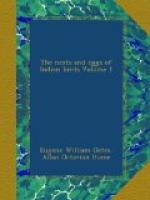“The total length of their breeding-ground in any district must be close on 200 miles, but entirely confined to the banks of the river. If you looked four miles from, the river, one side or the other, you would not see one. Can Pastor roseus breed in India in some similar secluded spot? I have been rather unlucky in getting their eggs, as at each place which I visited personally the birds had either young ones or were just going to lay.”
The eggs of this species are moderately broad ovals, sometimes slightly elongated, always more or less appreciably pointed towards the small end. The shell is extremely smooth and has a fine gloss. The colour, which is extremely uniform in all the specimens, is an excessively delicate pale blue with a faint greenish tinge, a very beautiful colour. They vary from 1 to 1.18 in length, and from 0.71 to 0.82 in breadth.
537. Sturnia blythii (Jerdon). Blyth’s Myna.
Temenuchus blythii (Jerd.), Jerd. B.
Ind. ii, p. 331.
Sturnia blythii (Jerd.), Hume, cat.
no. 689.
Mr. Iver Macpherson sent me from Mysore three eggs and a skin of a Myna, which latter, although in very bad order, is undoubtedly S. Blythii. He says:—“It is very possible that the bird now sent is S. malabarica, and it is such a bad specimen that I fear it will not be of much use to you for the purpose of identification. I think it is Sturnia blythii, as Jerdon says that S. malabarica is only a cold-weather visitant in the south of India.
“I will, however, try and procure you a good specimen of the bird. It is only found in our forests bordering the Wynaad, and as it is far from common, I am not well acquainted with it.
“I am also inclined to think that it is not a permanent resident with us, but that a few couples come to these forests only to breed.
“The only nest I have ever found was taken on the 24th April, 1880, and was in a hole of a dry standing tree in a clearing made for a teak plantation and contained three fresh eggs.
“A few days subsequently I saw a brood of young ones flying about a dry tree in the forest, so probably the breeding-season here extends through April and May.”
The eggs are very similar to those of Sturnia malabarica and S. nemoricola, but perhaps slightly larger. They are moderately elongated ovals, generally decidedly pointed towards the small end. The shell is very fine and smooth, and has a fair amount of gloss. In colour they are a very delicate pale greenish blue. They measure 0.99 and 1 in length by 0.71 in breadth.
538. Sturnia malabarica (Gm.). The Grey-headed Myna.
Temenuchus malabaricus (Gm.), Jerd. B. Ind.
ii, p. 330; Hume, Rough
Draft N. & E. no. 688.




